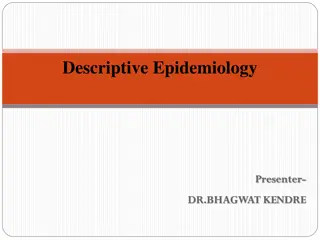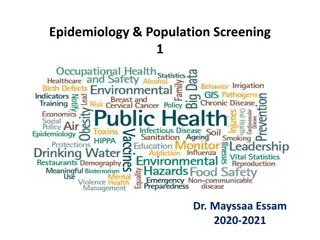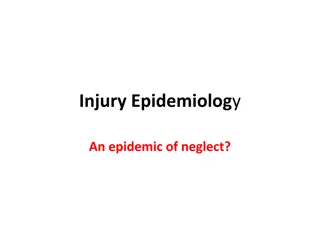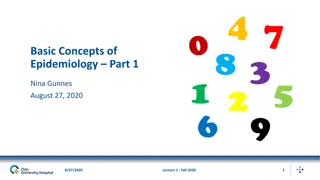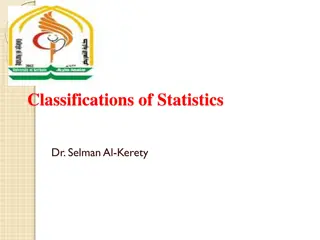Descriptive Epidemiology in Public Health
Descriptive epidemiology involves the study of disease occurrence and distribution in populations. It focuses on describing patterns of disease occurrence based on who gets sick, where rates are highest and lowest, and temporal patterns of disease. Descriptive studies are essential for public health administrators to allocate resources effectively and for epidemiologists to identify risk factors in disease prevention.
Download Presentation

Please find below an Image/Link to download the presentation.
The content on the website is provided AS IS for your information and personal use only. It may not be sold, licensed, or shared on other websites without obtaining consent from the author.If you encounter any issues during the download, it is possible that the publisher has removed the file from their server.
You are allowed to download the files provided on this website for personal or commercial use, subject to the condition that they are used lawfully. All files are the property of their respective owners.
The content on the website is provided AS IS for your information and personal use only. It may not be sold, licensed, or shared on other websites without obtaining consent from the author.
E N D
Presentation Transcript
Epidemiology EPI DEMO LOGOS Upon,on,befallPeople,population,man the Study of The study of anything that happens to people That which befalls man
Descriptive studies Descriptive Individual Case report Case series Cross sectional studies Populations{Correlational studies}
Descriptive Epidemiology Study of the occurrence and distribution of disease Terms: Time Place Person
Descriptive Studies Relatively consuming than analytic studies, they describe, inexpensive and less time- Patterns of disease occurrence, in terms of, Who gets sick and/or who does not Where rates are highest and lowest Temporal patterns of disease Data provided are useful for, Public health administrators (for allocation of resources) Epidemiologists (first step in risk factor determination)
Descriptive Studies Case reports Case series Cross sectional studies Correlational studies
CASE REPORT AND CASE SERIES Case reports and case series represent the most basic type of study design, in which researchers describe the experience of a single person (case report) or a group of people(case series). Typically, case reports and case series describe individuals who develop a particular new disease or condition. The identification of a new or recurring health problem often begins with a case report or case series
CASE REPORT AND CASE SERIES Example: A case series describes 20 women who develop cervical cancer; 9 of these women report at least once weekly ingestion of foods packaged with aluminum foil. Urine testing confirms the presence of aluminum among all 9 case women. NB: it is tempting to conclude that aluminum foil causes cervical cancer.
Case Reports (case series) Limitation 1) Case reports / case series lack denominator data that are necessary to calculate the rate ofDisease: Disease rates are needed for comparison with historically reported disease rates, or with rates from a selected comparison group. Unfortunately, obtaining the necessary denominator data may not be easy. 2) Case report / case series report data lack comparison group. 3) Case reports / case series studies often describe highly select individuals who may not represent the general population.
SCENARIO 1 1) The classic description of a series of infants born with congenital cataracts, some with additional cardiac abnormalities, in Australia in 1941. This led Dr N. M. Gregg in Sydney to postulate a causal link between a severe epidemic of rubella (German measles) that had occurred six to nine months before the children were born and the subsequent abnormalities (Gregg, 1941). NB: It is now well known that if a woman develops rubella during pregnancy it may affect her unborn baby.
SCENARIO 2 2) A case report published in the UK in 1961 described the development of a pulmonary embolism in a 40- year-old pre-menopausal woman, five weeks after she had started using an oral contraceptive (OC) to treat endometriosis (Jordan, 1961). The author suggested that it might have been caused by the OC, particularly since it was a new exposure at that time. NB: A report of one case could not provide conclusive evidence that it was the OC. These have consistently shown that there is an association between the use of OCs and the risk of this condition.
Cross-Sectional Studies (prevalence studies) A cross-sectional study refers to a study design in which ascertainment of the exposure and the outcome occurs simultaneously. Measuring the exposure and outcome at the same time implies that there is no follow-up time.
Cross-Sectional Studies In cross sectional studies, information about the status of an individual with respect to the presence or absence of exposure and disease is assessed at a point in time. The point in time may be as short as few minutes or as long as two or three months. The time frame of "point in time" is based on the speed of data collection.
Cross-Sectional Studies (prevalence studies) Measures disease and exposure simultaneously in a well-defined population Advantages They cut across the general population, not simply those seeking medical care Good for identifying prevalence of common outcomes, such as arthritis, blood pressure or allergies are less expensive & easier to conduct Limitations Cannot determine whether exposure preceded disease It considers prevalent rather than incident cases, results will be influenced by survival factors
Correlational Studies (Ecological Studies) The simplest type of study is an ecologic study (also called a correlation study). In this type of study information is collected not on individuals but on groups of people. The unit on which measurement is made may be for example schools, towns, countries, etc. They use aggregate data and do not measure outcomes and risk factors. They are used to compare different groups, such as populations from different regions or countries, or groups from different types of employment
Correlational Studies (Ecological Studies) Uses measures that represent characteristics of entire populations It describes outcomes in relation to age, time, utilization of services, or exposures ADVANTAGES We can generate hypotheses for case-control studies and environmental studies We can target high-risk populations, time-periods, or geographic regions for future studies
Correlational Studies LIMITATIONS Because data are for groups, we cannot link disease and exposure in individual Data represent average exposures rather than individual exposures, so we cannot determine a dose-response relationship Caution must be taken to avoid drawing inappropriate conclusions, or ecological fallacy
Correlational Studies Ecologic ( correlation ) studies can be used in determining association plot : disease (population) burden [ Y axis ] vs. prevalence of risk factor [ X axis ] e.g. contraceptives vs. Breast cancer correlation coefficient : r ; + 1 to -1



